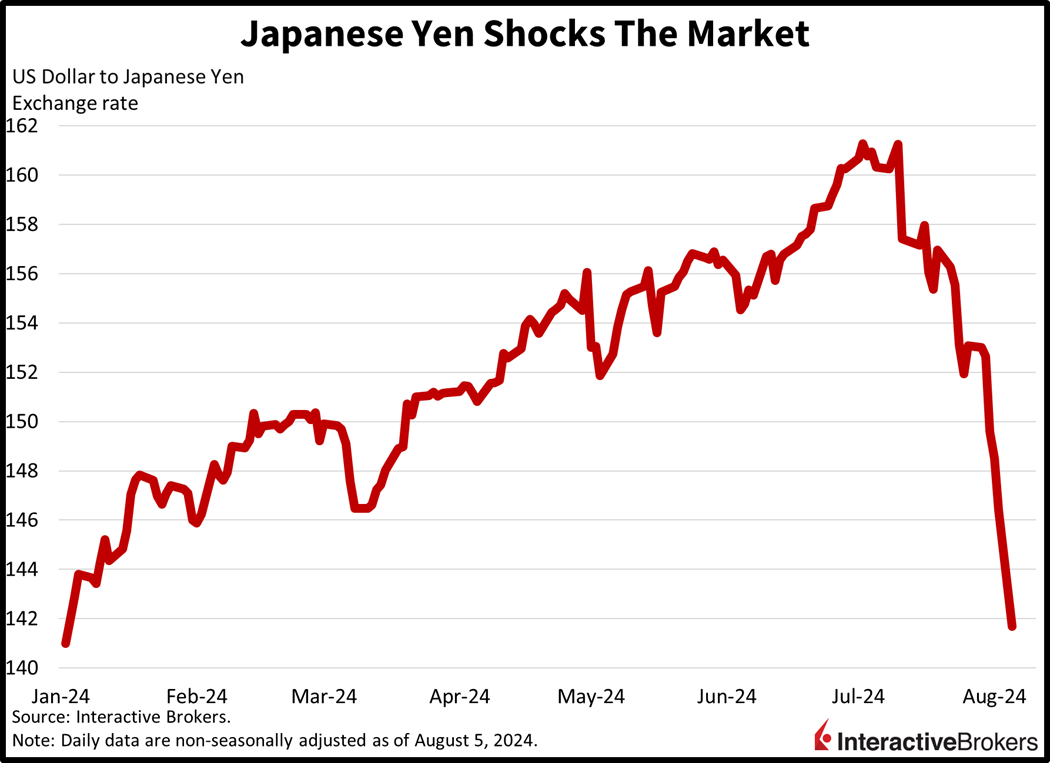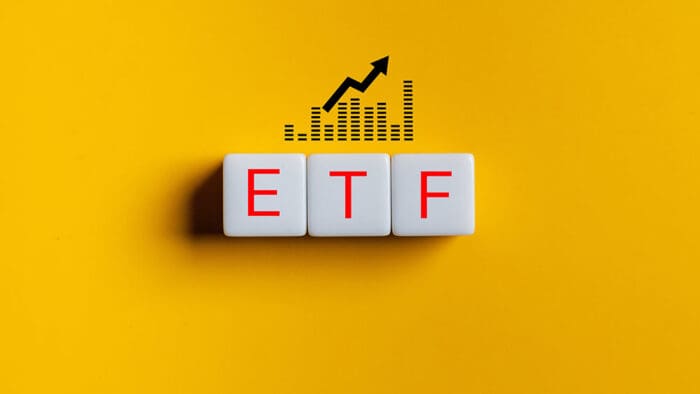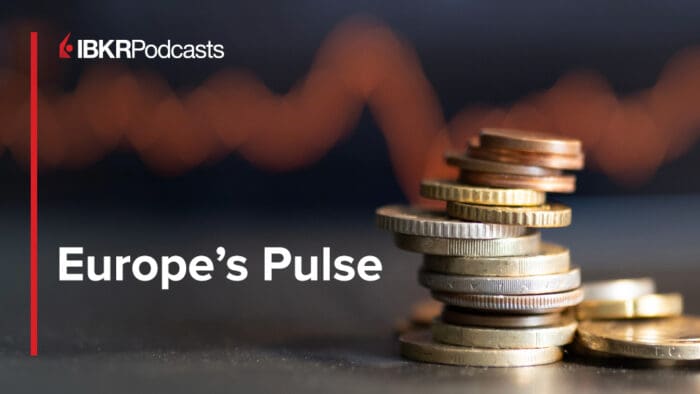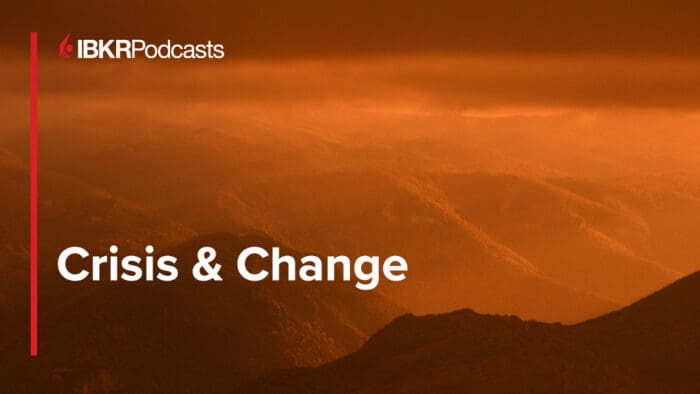Markets are experiencing historic selling pressure on the back of a painful deleveraging process thanks to a sudden and unexpected surge in the Japanese yen. The abrupt strength in Tokyo’s currency was caused by a surprise rate hike at the BoJ’s monetary policy meeting last month. To add fuel to the fire, last week’s news depicting rapidly deteriorating labor conditions stateside was the straw that broke the camel’s back. Indeed, carry traders were borrowing in yen and parking the proceeds in higher-yielding bonds and tech stocks, but now that both borrowing costs and the currency’s muscle have strengthened, these levered players are left with rising interest expenses and requirements to cough up more foreign coins to pay back the firmer Japanese tender. The volatility index (VIX) has hit its tallest level since the Covid-19 pandemic, as traders contend with global margin calls and fears of a US recession.
ISM Eases Equity Downturn
Stocks are off their lows, however, a result of the Institute for Supply Management’s Purchasing Managers’ Index (PMI) for Services arriving stronger than expected and softening worries of an imminent US downturn. July’s ISM-Services score of 51.4 exceeded the projected 51 level and the 48.8 result for June. Driving the upside beat were the production, new orders and employment components, which came in above the contraction-expansion threshold of 50 at 54.5, 52.4 and 51.1. But revenue strength came at the expense of higher prices, with the cost segment jumping to 57 from 56.3.

BoJ, BLS and a Cautious Warren Buffett Hurt Sentiment
Last week’s surprise hike by the Bank of Japan (BoJ) and Friday’s disappointing US jobs data contributed to a rocky start to risk assets this morning. Meanwhile, Berkshire Hathaway disclosed that the firm has slashed its exposure to Apple and Bank of America, causing its cash balance to swell.
When the BoJ made the change last week, it was clear that central bankers needed to defend the weakening yen even if doing so increased the chances of the country’s economy weakening under the burden of higher financing costs. Indeed, the bank noted that it reached the decision based on concerns that the country’s weak currency presented increased risks of escalating price pressures. In the US, Friday’s Bureau of Labor Statistics data also struck fear among investors. In July, nonfarm payrolls climbed by 114,000, missing the expected increase of 176,000 and falling from June’s downwardly revised level of 179,000. The gain in average hourly earnings also weakened and the unemployment rate inched up 20 basis points (bps) to 4.3%, a fourth-consecutive monthly increase.

Berkshire Trims Equities While Carlyle Group Misses Expectations
Berkshire Hathaway (BRK) generated much interest with its disclosures that it has reduced exposures to two large positions while revenue for private-equity investor Carlyle Group fell short of expectations.
Last week, Berkshire Hathaway disclosed selling nearly $779 billion of Bank of America shares. The firm also sold nearly half of its Apple stake and has invested the proceeds in US Treasury Bills. In the past, Buffett has said high valuations have created a shortage of investment opportunities that could have a meaningful impact on the company’s investment portfolio. Berkshire Hathaway’s operating earnings met expectations while revenue including gains and losses from holdings declined from $125.6 billion in the year-ago quarter to $117.5 billion. When adjusting for one-time items and excluding investment losses and gains, revenue climbed 1.2%. Strong results for Berkshire Hathaway’s insurance holdings, however, resulted in operating earnings growing 15.5% y/y after excluding the impact of investment gains and losses. BRK is down 3.58% this morning.
Private equity firm Carlyle Group (CG) earnings missed the analyst consensus expectation but revenue beat estimates. During the first six months of this year, the company produced an all-time high level of fee income and during its earnings call this morning, Chief Executive Officer Harvey Schwartz provided an optimistic outlook for the company’s investment holdings. Despite the recent market volatility, he believes Carlyle Group’s proprietary portfolio data points to GDP and anticipated Fed rate cuts this year, supporting investments. The company has raised $18 billion year to date, and it has acquired Discover Financial Services’ loan portfolio in a $10 billion transaction.
Selloff Continues Despite Favorable ISM Data
Risk-off sentiments are driving markets, causing stocks, commodities, crypto and the dollar to get pounded. All major US equity benchmarks are down, with the Russell 2000, Nasdaq Composite, S&P 500 and Dow Jones Industrial indices travelling south by 3%, 2.7%, 2.3% and 2.1%. Every sector is lower and energy, technology and consumer discretionary are leading the bears; they’re losing 2.4%, 2.2% and 2.1%. Treasurys were getting bid up on recession worries which were extinguished by the firmer ISM-Services print. The 2- and 10-year Treasury maturities are relatively unchanged and changing hands at 3.9% and 3.8%. The dollar is down 59 bps as the greenback depreciates versus the euro, franc, yen, yuan and Canadian dollar but appreciates relative to the pound sterling and Aussie dollar. Commodities ex-lumber are down, with silver, copper, crude oil, and gold lower by 4.3%, 2.5%, 1.9% and 1.4%. Lumber is up 0.7% as lighter borrowing costs improve the outlook for the real estate sector. Recession or not, the American Dream remains extremely desirable. WTI crude is trading at $73.27 per barrel on fears that a global economic slowdown will shatter demand conditions.
Future Econ Prints Create Opportunities
I frequently hear stories of traders that are correct when anticipating economic developments, but inaccurate in predicting how events will impact asset prices, often resulting in heavy portfolio losses. But now, traders can invest in specific economic events using IBKR’s Forecast Trader without worrying whether figures are already priced into markets or if a data release will serve as a “sell the news event.” Specifically, three opportunities stand out to me in upcoming releases. The Yes contract for August unemployment above 3.9%, the Yes contract for July Consumer Price Index (CPI) above 2.5% and the No for Fed Funds above 5.125% in September. For unemployment, odds are priced at 12% of the release being 3.9% or below, but the chances are closer to 0%, because a 40 bp slip in joblessness is almost impossible on a month-to-month basis considering late-cycle dynamics. For CPI, 2.5% would be the lightest number since February 2021 and my in-house model reflects a figure of 3%. While the odds of a number at or below 2.5% are currently priced at 6%, I would say this probability is nearly 0, so it’s a nice score for the yes crew. Finally, Fed Funds presents an arbitrage opportunity, with the No carrying just an 82% chance of being correct, but the futures market assigns a probability of almost 100%, offering a sizeable advantage to the No contract holders.
Systemic Stress Is Possible
With the market selloff especially intense among financial institutions in Europe and Japan, investors are wondering whether there are any systemic banking risks that we have yet to learn about. These challenges may certainly lead to monetary authorities introducing emergency actions in order to quell concerns related to liquidity and soundness, like during March of 2023. Against that backdrop, however, last Friday’s dismal payrolls print was just one report, that I believe can easily be forgotten if subsequent ones point to firmness rather than sluggishness. Still, however, concentrated job gains amidst broad labor weakness warrant late-cycle positioning and caution by the investor community.
Visit Traders’ Academy to Learn More About Nonfarm Payrolls and Other Economic Indicators
Join The Conversation
If you have a general question, it may already be covered in our FAQs. If you have an account-specific question or concern, please reach out to Client Services.
Leave a Reply
Disclosure: Interactive Brokers
Information posted on IBKR Campus that is provided by third-parties does NOT constitute a recommendation that you should contract for the services of that third party. Third-party participants who contribute to IBKR Campus are independent of Interactive Brokers and Interactive Brokers does not make any representations or warranties concerning the services offered, their past or future performance, or the accuracy of the information provided by the third party. Past performance is no guarantee of future results.
This material is from IBKR Macroeconomics and is being posted with its permission. The views expressed in this material are solely those of the author and/or IBKR Macroeconomics and Interactive Brokers is not endorsing or recommending any investment or trading discussed in the material. This material is not and should not be construed as an offer to buy or sell any security. It should not be construed as research or investment advice or a recommendation to buy, sell or hold any security or commodity. This material does not and is not intended to take into account the particular financial conditions, investment objectives or requirements of individual customers. Before acting on this material, you should consider whether it is suitable for your particular circumstances and, as necessary, seek professional advice.
Disclosure: Forex
There is a substantial risk of loss in foreign exchange trading. The settlement date of foreign exchange trades can vary due to time zone differences and bank holidays. When trading across foreign exchange markets, this may necessitate borrowing funds to settle foreign exchange trades. The interest rate on borrowed funds must be considered when computing the cost of trades across multiple markets.




















After hours looks like there is buying interest at these levels.